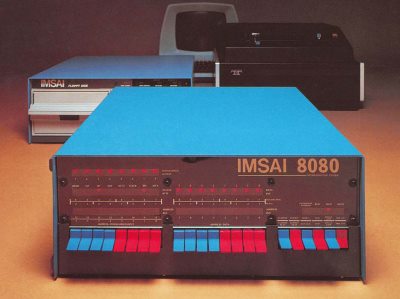IMSAI
was founded by an ex IBM employee, William Mallard, as a business called IMS
Associates, Inc., in 1973. It was located in San Leandro CA. IMS stood for
Industrial Micro Systems. They did contract hardware/software work for business
and the government. One project they had was the development of a
"Hypercube" -- a multiprocessor 8080 CPU system allowing parallel processing. As
the project evolved they needed a disk operating system (hardware and software).
Apparently they had difficulties with a CDC hard disk system and looked into
developing a CP/M based system (then new) on an Altair computer. They were
unsuccessful in working out an arrangement with Altair and so Joe Killian their
chief engineer decided to build an Altair clone. They quickly found that
there was interest and demand from computer hobbyists for such a system. In 1975
they made a name for themselves by providing a much better constructed "S-100"
system utilizing sound engineering designs they had learned from the work above.
The company took off.
To finance rapidly growing operations,
IMSAI pledged 20% of its stock as convertible note in exchange for $250,000 from
the investment firm Marriner & Co. In 1976, in partnership with
others IMS launched a successful computer reseller franchise ComputerLand.
In 1982, ComputerLand's sales reached over $400 million and by 1984 the venture
reached over $1 billion in revenue. However legal troubles from the failure of
IMS, centered largely on a convertible note from the Marriner partnership that
was later sold to a group of investors, led to a lawsuit in which Millard lost a
substantial portion of his stake in ComputerLand. In the late 1980's Millard
relinquished control of ComputerLand. In 1987, he sold ComputerLand to E.M.
Warburg, Pincus & Co. for about $200 million. Apparently there were
serious management problems at IMSAI almost from the beginning with large
salary discrepancies between executives and staff compounded with unrealistic
tasks and goals. In spite of its early start in the business it quickly lost out
to other competing companies. Nevertheless the IMSAI 8080 box to
this day probably represents the image most associated with the S-100 bus. Over
15,000 of them were manufactured. Working systems on eBay have reached over
$3000. The rights to the IMSAI name, materials, documentation etc have
been obtained by a guy named Todd Fischer who started a company called
Fischer-Freitas Company. He has a web site at
http://www.imsai.net/ where he describes an IMSAI Series II. This is a S-100
bus/IBM-PC proto-type hybrid. Todd unfortunately is seriously ill -- we
wish him well.


